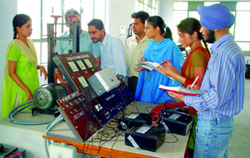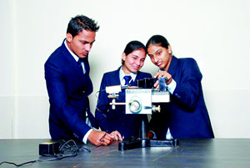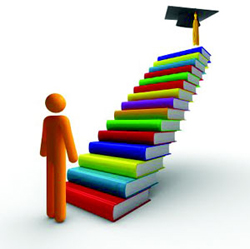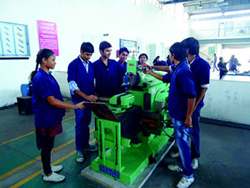Rethinking Technical Education in India
A.K Jain- Former Commissioner (Planning), Delhi Development Authority
India has landed right at the bottom of the survey of higher educational quality across 50 major nations conducted by Universitas 21, an international network of leading research-intensive universities.
-Times of India, 14th June 2012
Since 2011, 225 Schools and 52 Engineering Colleges both undergraduate and post graduate across India have downed shutters. Many more colleges have trimmed programmes, branching of engineering or streams in the management courses.
-Times of India, 9th October 2012
| India has one of the largest technical education systems in the world. More than 8000 degree institutes and 2500 polytechnics offer about 1.5 million seats at the entry level in the degree stream, 0.5 million in the polytechnics. According to the Ministry of Human Resource Development (MHRD) by 2022 India aims to have 500 million skilled people. Forecasts suggest that, if current patterns of participation continue, more than 30 percent of school leavers will take up higher education in next 10 years. The present GER of about 15 percent is being pushed to 30 |
 |
percent, which mean more facilities and openings in higher education. For a country which, as World Bank says, has only 25 percent of its graduate’s employment-ready, it is a worrisome scenario. While countries like Australia, Germany, and South Korea have robust systems and infrastructure of skills development and vocational training, India has yet to wake up and tackle skill deficit with astute policy decisions and effective implementation. It is a paradox that India is facing the unemployment of millions of educated youths while facing a serious crunch of employment ready professionals. The education imparts one kind of training to the students, whereas the industry and markets are looking for another kind of skills set. There is an obvious disconnect between education imparted and the market demand. To add to this, there are newer, emerging areas in which new skills are required. Skill development is closely linked with the employment potential and economic development and need to respond to a changing scenario.
As per FICCI- Ernst & Young report (2010) the higher education expenditure during next 5 years is going to be Rs. 1,55,015 Crores and it will be around Rs 3,60,640 crores by 2020. This amount accounts for around 1.9 % of the current GDP based on Purchasing Power Parity. Realizing the need to increase the public spend on higher education from a mere 0.7% of GDP in the Eleventh Plan, the government is proposing to raise it to 1 percent of the GDP during the Twelfth Plan. That would still leave a deficit which needs increased investment and private sector participation.
The Quality Aspect
| The quantitative aspects of higher education cannot be separated from its qualitative and financial aspects. The 2012 Times ranking of the global universities demonstrate that the top 300 universities of the world are concentrated in USA (94), Canada (17), UK (39), Europe (90), Australia and New Zealand (15) and Asia (37). Unfortunately not even a single university from India falls within top 300 of the world. The Times Higher Education World Ranking is broadly based on the five criteria, viz. teaching (30%), |
 |
research (30%), citation (30%), industry income (2.5%) and international outlook (7.5%). Policy papers from MHRD, University Grants Commission (UGC) and All India Council for Technical Education (AICTE) do discuss of world class education, but we have a long way to go in order to integrate it into mainstream, quality education. Technical education needs innovative methodologies, sophisticated blend of advanced technological equipments, creative mind-scape and a vision of collective excellence. According to Prof S S Mantha, Chairman of the All India Council for Technical Education (AICTE) the foremost aspects of education are the student, the faculty and the institution. If these aspects are evaluated individually and plotted for an institute, it would enable us to identify the gaps that will help in improving its performance The underlying layers that form the crux of the rating are the following:
- the student: Admission process, competence, motivation, foundation, gender balance, affordability, financial, regional and aspirational mapping
- the faculty: Teaching style, technology, motivation, team spirit, institution building and management , innovational and aspirational mapping
- the institution: Its ability to balance between local, national and global outlook and competence infrastructure facilities, non-academic development, equity and inclusion, jobs, integrity, promoting research, retain faculty, industry-education interface and consistently out-perform its accomplishments.
There is tremendous pressure on the system to respond to the new expectations, like finding suitable teaching faculty, retaining them over long periods of time, facilitating them to grow amongst their peers, an enabling mechanism to prosper in the societal expectations, and a suitable placement for almost 1.5 million youngsters graduating from technical Institutes every year. It would be worthwhile to note that a student with 50 percent minimum eligibility at the qualifying examination also gets into this system along with the student at the top of the ladder. Unfortunately a normalisation of the process caters to common denominator and hence a fall in standard. The examination systems, being what they are, cater to this common denominator that aid in propagating mediocrity. A university professor once set an examination question in which he asked "what is the difference between ignorance and apathy". The professor had to give an A+ to a student who answered: "I don't know and don’t care".
Investigations have revealed that many faculty members are experiencing dissatisfaction in their work environments. A longitudinal study by Sorcinelli, for example, found 33% of new faculty in their first year reported being very stressed. This percentage rose to 49 percent in year two, and went to 71% in year five. A new PhD faculty or someone who has worked in industry and joins a university, is faced with many tasks. The faculty member must learn the procedures at the Institution/university, teach, examine the student and get involved in research programs. Some universities also involve the teachers in the admission process.
Whether Teaching or Learning?
| Being a visiting faculty in Management and Planning courses, I observed that on an average out of 30 students 4 to 6 occupied with the mobile phones, 3 to 5 students busied with their laptops, and 6 to 8 students talked among themselves, besides 4 to 6 students usually missing. At the end of two hour session, I would ask simple questions and take the debriefing where on an average only 3 students, that is merely 10 %, seemed to absorb something. The general reaction of my colleagues in the |
 |
faculty was that there was a lack of discipline and interest among the students, too many diversions and distractions, changing values and poor educational background. However, I was keen to hear from the horse’s mouth. 60 to 70 per cent students found the lectures boring, complicated, overloaded, difficult, punishing and even intimidating. They were hardly impressed by the prefixes and suffixes of the faculty like professor and doctor, but valued simple, comprehensible, interesting and interactive talks.
This made me to think and develop a style which made the subject absorbing and interesting and the students more involved. They were motivated to attend the class for something interesting and new and not just for the sake of minimum attendance. This made me to realize the importance of simplifying the ways of explaining the difficult and complicated topics (without hiding the complexity of the simple). The students were in focus, not the teacher and his intellectual excellence. Anecdote style, a dash of humour and a consistent story-line with clarity and simplicity did the magic. The metaphors, graphics, matrix charts and case studies helped to simplify the complex, generating interest among the students. Group exercises were given to the students where the faculty acts as a friendly guide and facilitator. The teacher climbs down from the high pedestal of 'guru' and mixes up with the students giving them personal touch and attention. At the end, students have the pride of achievement and take away. The practical lesson is that there is a wide gap between teaching and learning. In fact the purpose of education is learning not teaching.
Too much focus on teaching marginalizes the students and the institutional competence. Overvaluing intellectualism and personal credential make teaching too overloaded and complex for the tender minds of young students. As a result, education is often divorced from learning and its application in real life. Gaps exist between academic idealism and pragmatic process. Advertisements fail to live up to the standards and commitments. There is a cut throat competition among the institutes each aspiring to become an island of excellence, ignoring the principle of synergy and networking.
Several areas need to be tackled for excellence in technical education of which the following are critical:
- Educational methods and active learning
- Interfacing soft and hard mediums
- Education and Industry Interface
- Level, Standards and Learning Curve
- Sustainability and Cross-disciplinarity
Active Learning
| Albert Einstein stated that ‘the only thing that interferes with my learning is my education’ Learning cannot be imposed on students but must be a common journey led by the students themselves. In an experiment, attempting to change the cooking and food habits of the housewives in World War II, one group of women was given lecture on the advantages of new food and the way of preparing them. Another group participated in a group discussion on the same subject. The result was that only 3 % of the first group changed their food habits while 30% of those who had participated in the group discussions changed their food habit.Learning involves investment of time, energy, finances and other resources. The same student learns many more times by active participatory method |
 |
than in a routine examination style. This implies that the method of learning (and teaching) makes all the difference. This is why some institutes become a brand while many others, keep struggling. Any amount of advertisement and publicity is not going to make much difference. What needs to be done is to adopt new ways of teaching and learning, where student picks up the most within the available time. The fear of attendance should not be the reason to make a student to sit in the class, but s/he is motivated in the subject and develops an urge, a thirst to learn.
Learning is an active process which leads to change in attitudes, understanding, skills and behavior. Studies indicate that learning is most likely to occur when people have participated actively in the process. Participatory active learning has various forms such as group discussion, seminar, quiz, roundtable, etc. It aims at:
- Stimulating interest and personal involvement
- Clarifying the thinking of the individual,
- Providing the means of testing and evaluating one’s ideas
- Helping one to see different ways of looking
- Providing instant feedback
- Pooling knowledge
Some of the useful tools of participatory learning are :
- Team building,
- Humour,
- Graphics,
- Matrix charts,
- Case studies,
- Quiz,
- Metaphors,
- Anecdotes,
- Objective - subjective balance
- Story-line
Learning and problem solving involves:
- The statement of the problem
- The analysis of the problem
- The collection of relevant facts
- The development of alternative solutions
- The testing of facts against proposed solutions
- The assessment of available resources
- The plan of action-who will do what, when, where and how.
The foundation of learning and professional temperament is organized thinking. This helps in converting the dreams into plan and action, where professional skills and management are the resources. Learning is a lifelong process, which comprises the following eight steps:
- Cleaning, de-cluttering, emptying, opening locks, unlearning
- See, observe, retain childlike curiosity, focus.
- Listen, sharpen the knive, meditate
- Understand, digest, penetrate, assimilate, categorise, synthesise
- Rigour, be exact and delivery
- Values
- Professional attitude towards learning
- Lifelong learning, refine, review and experiment
The process of technical education must lead to transformation of a layman into a professional, of which organized thinking is the cornerstone with the following attributes:
The Attributes of a Professional and a Layman
| Professional |
Layman |
| Position as it is |
Judgemental, temperamental |
| Open, fresh and clear mind |
Personal preferences/likings |
| Observation |
Prejudices |
| Simplifying the complex |
Complicating simple things |
| Originality |
Relies heavily on popular media and gossips |
| Understanding, process learning |
Borrowed, teaching, correcting |
| Facts and figure |
Weak facts, figures and fiction |
| Empirical analysis, logic |
Default logic, fault finding |
|
Conceptualisation
|
Winding statements, piecemeal ideas |
| Framing right questions |
Jumping to conclusions and answers |
| Relate to context, specific |
Generalisation |
| See positive side, learn from success |
Over critical, learn from failures |
| Continuity, clairity of communication |
Ad-hoc statements, jumps |
| Aggregation, big picture |
Fragmentation, piecemeal, disjointed |
| Objective |
Subjective, image worship |
| Literature scanning/references/credits |
Poor reading/ no references/no credit |
| Structured thinking |
Flesh without bones, cosmetic |
| Honest, practical, examples, illustrations |
Too verbose, jargons |
| Evolving, innovative, transformative |
Rigid, fixed |
Soft and Hard Mediums
According to the Roger Van Oech (A Whack on a side of the Head) things are not always in black and white. There are many shades of grey and different colours. It is easy to pick up solid or something on the hard side-like bar of metal, while the soft things are of more difficult to grab-like air and water.
Soft thinking is metaphorical, approximate, diffuse, humourous, playful and capable of dealing with contradictions.. Hard thinking on the other hand, tends to be more logical, precise, exact, specific and consistent. Hard thinking is like a spotlight bright, clear and intense, but the focus is narrow. Soft thinking is like a floodlight. It is more diffuse, not as intense, but covers a wider area. Soft teaching methods educate the student by triggering his own thinking and search for connections, rather than on their differences. Every Indian has the background (Sanskar) of soft thinking- mythology, metaphors, dreams, play, etc.,which can be cross-breeded with hard mediums for effective learning.
Education and Industry Interface
In order to bridge the gap between learning and practice, as well as to equip the students to play a vital role in the development process, the following reforms are necessary in the technical education:
- New methods of learning
- Formal interface and exchange of education and research with industry, government and practice. Attachment of a technical institute with field department/agency similar to medical college attached to hospital would go a long way in this respect
- In-service training and QIP.
- Faculty orientation and international exchange to develop a centre of excellence.
The present slant towards theory and ideology needs to be integrated with the ground reality and delivery, which include financial, legal, administrative and political processes.
Levels, Standards and Learning Curve
The mission of education is to equip and enable the student to take up adequately and effectively the responsibility of sustainable, equitable and inclusive development. The structure of education comprises 3 levels - core learning/mono-discipline focus (Diploma), Professional/multi-disciplinary focus (Graduate), and Research/Specialised learning ( Masters, Ph.D, QIP, Trg.). The technical education is a demand driven activity and the process of learning starts with basic /core learning. It builds-up into professional education that further leads to various specializations. Learning process encompasses:
- Knowledge and Information Management
- Reflection and observation
- Conceptualisation
- Translating learning into action
The skill necessary to be developed in each segment may include the following critical areas:
Skill Development- Examples of Critical Areas
| Learning |
Skill Development |
| Knowledge |
Knowledge-knowing the unknown
- Information System Development and Application
- Procedures
- Basic Theory /Principles
|
| Reflection and Observation |
From Knowledge to Comprehension, Interpretation and Understanding
- Analysis
- Value System
- Interface with Environment, Technology, Legal. Institutional, Social and Financial aspects
- Understanding
|
| Concepts |
Conceptualising and Integrating the Abstract
- Vision
- Concept Development, Planning and Design
- Presentation and communications
|
| Action |
From Overview to Details, from General to Specific, from Thinking to Acting and Interacting
- Management, Organisation and Ethics
- Institution Frame, global research networking
- Implementation
- Cross disciplinary coordination of Environmental, Technical, Legal, Social, Cultural, Financial aspects
- Monitoring/Feedback
- Interacting, communication and negotiation Skills
|
The reforms in education and curriculum have to be derived from the process of Education-Industry interface. This essentially involves the following:
- Reassessment of the needs of the higher education vis-à-vis the levels, employment and potential development needs
- Practical learning, training/internship, linking technical/research institutes with field departments/companies
- Quality focus, striving for global standards and networks
- Curriculum reforms
- Career prospects
Sustainability and Con-disciplinarity
Our technical education remains hopelessly analytical, centred on compartmentalised disciplines, whose pieces overlap rather than fit together. It neither prepares a student for global approach to address the complex ptoblems nor for the interplay between them. Its results are visible in our day to day experiences-poverty, insanitation, traffic and transport, infrastructure, pollution, shortages of water, power and other services, etc. For sustainable and inclusive development, we must move from inter-disciplinary to condisciplinary education. It involves concieving a web of three dimensions as follows:
- A horizontal dimension of levels and streams of technical knowledge
- A vertical dimension that encompasses ecology, economics and humanities
- A third dimension that represents tools, processes, methods and values
The technical education needs to undergo a paradigm shift so as to enable it to connect with the realms of ecology, technology, economics, management, , humanities, etc. We are living in a world of finite and scarce resources. A sense of interdependence can break down the rigid boundaries and compartments and make technical education more sustainable and relevant to the development objectives. In this regard the University Leaders for Sustainable Future developed a ten point action plan, the Talloires Declaration, which was signed by 100 universities in 52 countries (2009). The Kyoto Declaration on Sustainable Development, 1993 at 9th International Association of Universities Round Table (IAU, 1993), the University Charter for Sustainable Development 1994, at the Conference of European Rectors (CRE) through its COPERNICUS programme (co-operation programme in Europe for Research in Nature and Industry through Coordinated University Studies)and the Bonn Declaration (2009) by the UNESCO World Conference on ESD, all establish a commitment to include sustainability in university curricula and teaching.
| The interdependency of technical education can be compared to the reflections of the countless jewels in the sky. Each of the jewels is not only tied to another, but they also mirror one another by reflecting the other jewels. Each is reflected in the facets of every gem. Therefore, not only all parts are connected, each part also contains the whole. With a cross disciplinary education, it is possible to respond to the breadth and depth of the realms of complex interdependence of development. This is necessary for the elimination of redundancy and for the solution of innumerable conceptual and methodological issues. |
 |
The layers of development constitute the technology, nature, culture and humanities. The greatest enterprise of the mind has always been the manifestation of the linkages of the constituents. As such, an institute is not a set of individuals, but a set of learning systems facilitating both the individual and overall excellence. This is manifested by education which integrates onto a composite development paradigm by linking education with the fields of technology, planning, design, construction, mobility, roads, buildings, works of the art, humanities, and so on.
References
Bono Edward de, 1970, Lateral Thinking, Penguin Books, London
Jain A.K., Curriculum Reforms in Town and Country Planning Education, ITPI, AICTE National Colloquium, 1999
Oech Roger Van, A Whack and the Side of the Head
Mantha S.S., June 2012, Technical Education in the New World Order in Digital Learning
Pearson Education, June 2012, Bringing about the Learning Revolution in Digital Learning,
Rawllingson, J.G., Creative Thinking and Brainstorming, Gohar, London
Shiba, Shoji and David Wallace, 1993, Four Practical Revolutions in Management, Centre for Quality of Management, Cambridge, Massachusetts